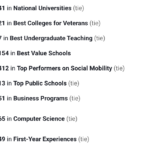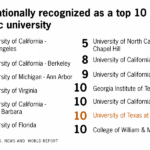US News university rankings significantly influence college applications and institutional strategies. These rankings, while widely consulted, employ complex methodologies with inherent biases. Understanding these methodologies, their impact on universities, and the public perception of their results is crucial for navigating the higher education landscape.
This analysis delves into the intricacies of US News university rankings, examining the weighting of various factors, the data sources used, and the potential for skewed outcomes. We will explore the influence of these rankings on university behavior, student choices, and the broader conversation around higher education quality and accessibility.
Ranking Methodology Exploration: Us News University Rankings
Understanding the methodologies behind US News & World Report’s and other publications’ university rankings is crucial for interpreting their results. These rankings significantly influence prospective students’ choices and institutions’ reputations, making a transparent and critical examination of their methodologies essential. Different ranking systems employ varying weights for different factors, leading to diverse outcomes and potential biases.
Different Methodologies Employed by Major Ranking Publications
US News & World Report, for instance, utilizes a complex formula incorporating various factors such as graduation and retention rates, faculty resources, student selectivity (acceptance rate), financial resources, and alumni giving. Other publications, like the Times Higher Education World University Rankings and QS World University Rankings, use slightly different methodologies, placing varying emphasis on research output, citations, and international outlook. While all aim to provide a comprehensive overview of university quality, their approaches differ significantly. The weight given to each factor also differs dramatically across ranking systems.
Weighting of Factors Across Ranking Systems
The weighting assigned to different factors reveals inherent biases within each ranking system. For example, US News & World Report places a relatively high weight on student selectivity, potentially favoring institutions with highly restrictive admissions policies, which may not necessarily reflect overall academic quality. In contrast, other rankings might prioritize research output, potentially favoring research-intensive universities over those focused on undergraduate teaching. A comparison of weighting schemes across major publications reveals substantial variation: US News emphasizes undergraduate teaching resources, while others emphasize research output and global reputation. Financial resources are often a factor, but the weighting varies, which can disadvantage institutions with limited endowments.
Potential Biases Inherent in Ranking Methodologies
Several biases are inherent in the methodologies used. The reliance on easily quantifiable metrics, such as test scores and acceptance rates, can overlook qualitative aspects of education, such as teaching quality and student engagement. Furthermore, the emphasis on certain factors, such as research output, might disadvantage institutions with a strong focus on teaching or community engagement. A significant bias is the inherent difficulty in accurately measuring subjective qualities like teaching effectiveness or the overall learning environment. The focus on quantitative data can also lead to a skewed representation of institutions that serve diverse student populations or prioritize different educational approaches. Finally, the rankings themselves can create a self-fulfilling prophecy, encouraging institutions to prioritize factors heavily weighted in the rankings, potentially at the expense of other important aspects.
Hypothetical Ranking System Methodology
A more balanced and comprehensive ranking system could be designed by incorporating a broader range of factors and employing a more nuanced weighting scheme. This hypothetical system would include:
- Student Outcomes: This would encompass graduation rates, employment rates after graduation, and graduate school acceptance rates, weighted at 30%. This focuses on the tangible results of a university education.
- Faculty Excellence: This would consider faculty research output, teaching evaluations, and awards, weighted at 25%. This accounts for both research and teaching contributions.
- Resource Allocation: This would assess financial resources, student-faculty ratio, and library resources, weighted at 20%. This acknowledges the importance of infrastructure and support.
- Diversity and Inclusion: This would evaluate the diversity of the student body, faculty, and staff, as well as the institution’s commitment to inclusive practices, weighted at 15%. This promotes a holistic view of the institution’s environment.
- Community Engagement: This would measure the university’s contribution to its local community through service learning, outreach programs, and partnerships, weighted at 10%. This reflects the broader societal impact of the university.
This hypothetical system attempts to mitigate some of the biases present in existing rankings by considering a broader spectrum of factors and avoiding an over-reliance on easily quantifiable metrics. The weighting scheme reflects a balanced approach, prioritizing student outcomes and faculty excellence while acknowledging the importance of resources, diversity, and community engagement.
Data Sources and Transparency
University rankings rely on a diverse range of data sources to assess and compare institutions. The selection and weighting of these sources significantly influence the final rankings, making transparency in data collection and methodology crucial for the credibility and trustworthiness of the results. A lack of transparency can lead to concerns about bias and manipulation, undermining the value of the rankings.
The primary data sources used in compiling university rankings typically include academic reputation surveys, student-to-faculty ratios, research output (publications and citations), financial resources, graduation rates, and alumni success. However, the specific data points and their weighting vary considerably across different ranking systems, leading to different outcomes. This variation highlights the importance of understanding the methodologies employed by each ranking organization.
Data Source Comparison Across Ranking Systems
The transparency of data collection and methodology differs significantly across prominent university ranking systems. Some systems provide detailed explanations of their methodologies, including the specific data points used, their weighting, and the data sources. Others offer less transparency, making it difficult to fully understand how the rankings are derived. This lack of clarity can lead to skepticism about the rankings’ objectivity and fairness. For instance, some systems may heavily weight certain factors, such as research output, potentially favoring research-intensive universities over those with a stronger focus on teaching. Conversely, other systems may place greater emphasis on student outcomes, leading to a different ranking order.
| Ranking System | Data Source | Weighting | Transparency Level |
|---|---|---|---|
| US News & World Report | Academic reputation surveys, faculty resources, student selectivity, graduation and retention rates, financial resources, alumni giving rate, graduation rate performance | Varies by category and weight is not publicly available for all factors. | Moderate; some methodology details are available, but weighting for some factors is not fully disclosed. |
| Times Higher Education World University Rankings | Teaching, research, citations, industry income, international outlook | Weightings are publicly available and vary slightly from year to year. | High; detailed methodology and weighting are publicly accessible. |
| QS World University Rankings | Academic reputation, employer reputation, faculty/student ratio, citations per faculty, international faculty ratio, international student ratio | Weightings are publicly available and vary slightly from year to year. | High; detailed methodology and weighting are publicly accessible. |
Ethical Considerations in University Rankings
University rankings, while seemingly objective measures of institutional quality, carry significant ethical implications. The use of these rankings influences student choices, resource allocation, and institutional priorities, raising concerns about fairness, accuracy, and the potential for unintended consequences. A critical examination of the ethical dimensions is crucial for ensuring responsible use and promoting a more equitable higher education landscape.
The current university ranking systems often embed biases and inequalities that distort the true picture of institutional merit. These rankings, frequently driven by metrics like research output, faculty citations, and student selectivity, inadvertently favor institutions with greater resources and established reputations, often perpetuating existing inequalities. This creates a self-reinforcing cycle where well-resourced institutions consistently score higher, attracting more funding and top students, further widening the gap with less-advantaged institutions.
Bias and Inequality in Ranking Metrics
Several ranking metrics inherently favor certain types of institutions and disadvantage others. For example, a heavy emphasis on research output disproportionately benefits research-intensive universities, while neglecting the strengths of teaching-focused institutions. Similarly, reliance on student selectivity metrics can disadvantage institutions committed to access and inclusion, as they may have a more diverse student body with lower standardized test scores. The reliance on easily quantifiable data, such as faculty citations, overlooks the qualitative aspects of teaching, mentorship, and community engagement, which are equally important aspects of a high-quality education. This skewed emphasis creates a system where institutions are incentivized to prioritize metrics over genuine educational improvements. For instance, a university might focus on attracting high-achieving students to boost its ranking, rather than expanding access to underrepresented groups.
Improving Ranking Systems to Address Ethical Concerns
To mitigate these ethical concerns, improvements to ranking methodologies are essential. One crucial step is diversifying the metrics used. Including measures of student learning outcomes, graduate employment rates, and community engagement would provide a more holistic assessment of institutional quality. Furthermore, incorporating measures of institutional diversity and inclusion, such as student and faculty demographics, could help address the bias against institutions committed to equal access. Transparency in methodology is paramount. Clear and detailed explanations of how rankings are calculated, along with the limitations of the metrics used, are essential for informed interpretation and critical evaluation. Finally, ranking organizations should engage in ongoing dialogue with stakeholders, including students, faculty, administrators, and the wider community, to ensure that the rankings reflect the diverse values and priorities within the higher education sector. The ultimate goal should be to create a system that promotes equity, transparency, and a more accurate representation of institutional excellence.
Impact on Specific University Departments
University rankings exert a significant influence on individual departments, extending beyond the overall institutional standing. The pressure to perform well in these rankings often shapes departmental priorities, resource allocation, and strategic planning. This impact varies considerably depending on the ranking system used and the specific department’s strengths and weaknesses.
The allocation of resources within a university is frequently influenced by departmental performance in rankings. Departments consistently achieving high rankings often attract increased funding, attracting top faculty and students, and securing lucrative research grants. Conversely, departments struggling in the rankings may face budget cuts, hindering their ability to compete and potentially leading to faculty departures. This creates a dynamic system where success breeds success, and underperformance can lead to a downward spiral.
Departmental Ranking Strategies
Departments actively employ various strategies to improve their rankings. These strategies often focus on enhancing research output, improving student outcomes, and bolstering faculty credentials. For example, engineering departments might emphasize securing large research grants from government agencies or industry partners, while business schools may focus on increasing the placement rates of their graduates in high-profile companies. This competitive environment incentivizes departments to prioritize metrics that are heavily weighted in the ranking methodologies.
Examples of Resource Allocation Based on Rankings
A hypothetical example illustrates this dynamic: Consider a university where the engineering department consistently ranks highly in national rankings. This success might lead to increased funding for new laboratories, state-of-the-art equipment, and endowed professorships. Conversely, a struggling humanities department might face reduced funding, potentially impacting course offerings and faculty hiring. In reality, these scenarios play out across many universities, albeit with varying degrees of intensity and impact. The effect is not always uniform, as institutional priorities and specific ranking methodologies can modify the outcome.
Impact on Faculty Recruitment and Retention, Us news university rankings
High rankings significantly impact a department’s ability to attract and retain top faculty. Departments with strong rankings often have an easier time recruiting leading researchers and professors. This is because highly-ranked departments are perceived as more prestigious and offer greater opportunities for research funding, collaboration, and career advancement. The prestige associated with a highly-ranked department can also help with attracting high-quality graduate students, further strengthening the department’s overall standing. The opposite is true for poorly-ranked departments; they may find it challenging to attract and retain talented faculty, potentially leading to a decline in research output and teaching quality.
Ultimately, US News university rankings present a multifaceted challenge. While offering a convenient, albeit imperfect, snapshot of institutions, they must be interpreted critically. Understanding the methodologies, biases, and limitations of these rankings empowers students, parents, and universities to make informed decisions, moving beyond simplistic numerical comparisons toward a more nuanced understanding of institutional strengths and values.
US News university rankings are a significant factor for prospective students, providing a broad overview of institutions. To understand Cornell’s standing within this system, it’s helpful to consult a dedicated resource like this one on cornell university ranking which offers detailed analysis. Ultimately, these rankings, while influential, should be considered alongside individual program strengths when making educational decisions.
US News university rankings are a widely consulted resource for prospective students. A strong contender frequently featured in these rankings is the University of Colorado Boulder; you can find detailed information on its current standing by checking out the university of colorado boulder ranking page. Ultimately, understanding these rankings helps applicants navigate the complex landscape of higher education options.



